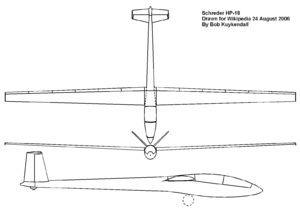PlaneSpottingWorld welcomes all new members! Please gives your ideas at the Terminal.
Schreder HP-18
| Type designation | HP-18 |
| Designer | Richard Schreder |
| Competition class | Club (formerly 15 metre) |
| Crew | 1 |
| Length | 22.8 ft (6.95 m) |
| Height | |
| Cockpit width | |
| Cockpit height | |
| Wingspan | 49.2 ft (15 m) |
| Wing area | 113 ft² (10.5 m²) |
| Aspect ratio | 21.4 |
| Wing profile | Wortmann FX 67-K-170 |
| Empty mass | ca. 470 lb (213 kg) |
| Water ballast | 200 lb (90 kg) |
| Maximum mass | 970 lb (440 kg) |
| Wing loading | 8.58 lb/ft² (41.9 kg/m²) |
| Maximum speed | knots ( km/h) |
| Maneuver speed | knots ( km/h) |
| Speed in strong turbulence |
knots ( km/h) |
| Minimum sink rate | ca. 110 ft/min (0.55 m/s) |
| Best glide ratio | ca. 40 at knots ( km/h) |
The HP-18 is a Richard Schreder-designed metal Racing Class sailplane that was offered as a kit for homebuilding during the 1970s and 1980s. It is one of the most successful of all North American homebuilt aircraft in terms of number built, with over one hundred kits sold and many completed.
Description
The ship has a forward fuselage of fiberglass and a sheet metal rear fuselage. The wing is built up from a metal spar with foam ribs to which the aluminum skin is bonded. This 15 m racing class ship carries water ballast inside the wing box spar, features flap-aileron coupling and has 90 degree deflecting flaps to permit steeper landing approaches and lower, safer touchdown speeds. The control stick is side-mounted with attached brake handle and trim tab although modifications using a conventional stick have been made.
Major features:
- Very low cockpit with reclining seating position
- Sidestick (changed to conventional stick by some homebuilders)
- Two-piece canopy (changed to single piece forward opening by some homebuilders)
- V-tail that folds upwards for easy storage
- Wing structure composed of spars with caps pre-machined from solid aluminium plate and aluminium wing skins bonded to closely spaced foam ribs
- Fiberglass fuselage pod, wing tip skids and tail fairings
- Aluminium tail cone
- Winglets added by some homebuilders
- Water ballast carried inside the hollow aluminium wing spars
- Typical Schreder trailing edge flaps/airbrakes partially interconnected with the ailerons
Variants
As most homebuilts, the HP-18 has been constructed with many variations in detail. Perhaps the most significant version is the HP-18W developed by Canadian Udo Rumpf, which features a modified wing airfoil, winglets, a front-hinged canopy, conventional control stick and higher ballast capacity.
Designation series
HP-7 - HP-8 - HP-10 - HP-11 - HP-12 - HP-13 - HP-14 - HP-15 - HP-16 - RS-15 - HP-17 - HP-18 - HP-19 - HP-20 - HP-21 - HP-22
Sources
- Schreder Designs webpage
- Sailplane Directory
- R Johnson, A Flight Test Evaluation of the HP-18W Sailplane, Soaring, July 2003

